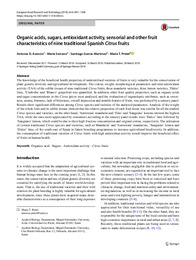Por favor, use este identificador para citar o enlazar este ítem:
https://hdl.handle.net/11000/30578Registro completo de metadatos
| Campo DC | Valor | Lengua/Idioma |
|---|---|---|
| dc.contributor.author | Asencio, Antonia Dolores | - |
| dc.contributor.author | Serrano, María | - |
| dc.contributor.author | García Martínez, Santiago | - |
| dc.contributor.author | Pretel, María T. | - |
| dc.contributor.other | Departamentos de la UMH::Biología Aplicada | es_ES |
| dc.date.accessioned | 2024-01-23T12:09:40Z | - |
| dc.date.available | 2024-01-23T12:09:40Z | - |
| dc.date.created | 2018-03 | - |
| dc.identifier.citation | European Food Research and Technology Volume 244 (2018) | es_ES |
| dc.identifier.issn | 1438-2385 | - |
| dc.identifier.issn | 1438-2377 | - |
| dc.identifier.uri | https://hdl.handle.net/11000/30578 | - |
| dc.description.abstract | The knowledge of the beneficial health properties of underutilised varieties of fruits is very valuable for the conservation of plant genetic diversity and agricultural development. The colour, weight, morphological parameters and total antioxidant activity (TAA) of the edible tissues of nine traditional Citrus fruits, three mandarin varieties, three lemon varieties, ‘Dulce’ lime, ‘Cimboba’ and ‘Blanco’ grapefruit was quantified. In addition, other fruit quality properties, such as organic acids and sugar concentrations in the Citrus juices were analysed, and the evaluation of organoleptic attributes, such as sweetness, aroma, firmness, lack of bitterness, overall impression and notable feature of fruits, was performed by a sensory panel. Results show significant differences among Citrus species and varieties of the analysed parameters. Analysis of the weight of the whole fruit and its edible tissues showed that the relative proportion of each fruit tissue was similar for all the studied Citrus species and varieties. on the other hand, ‘Autóctona’ mandarin and ‘Fino’ and ‘Sanguino’ lemons showed the highest TAA, while the ones most appreciated by consumers according to the sensory panel results were ‘Dulce’ lime followed by ‘Sanguino’ lemon, which could be due to their high fructose concentration and original colour, respectively. The utilisation of certain traditional Citrus species and varieties, such as’Mandarin’ and ‘Autoctona’ mandarins, ‘Sanguino’ lemon and ‘Dulce’ lime, of the south-east of Spain in future breeding programmes to increase agricultural biodiversity. In addition, the consumption of traditional varieties of Citrus fruits with high antioxidant activity would improve the beneficial effect of fruits in human health. | es_ES |
| dc.format | application/pdf | es_ES |
| dc.format.extent | 12 | es_ES |
| dc.language.iso | eng | es_ES |
| dc.publisher | Springer | es_ES |
| dc.rights | info:eu-repo/semantics/openAccess | es_ES |
| dc.rights | Attribution-NonCommercial-NoDerivatives 4.0 Internacional | * |
| dc.rights.uri | http://creativecommons.org/licenses/by-nc-nd/4.0/ | * |
| dc.subject | Organics acid | es_ES |
| dc.subject | Sugars | es_ES |
| dc.subject | Antioxidant activity | es_ES |
| dc.subject | Citrus fruits | es_ES |
| dc.subject.other | CDU::5 - Ciencias puras y naturales::57 - Biología::573 - Biología general y teórica | es_ES |
| dc.title | Organic acids, sugars, antioxidant activity, sensorial and other fruit characteristics of nine traditional Spanish Citrus fruits | es_ES |
| dc.type | info:eu-repo/semantics/article | es_ES |
| dc.relation.publisherversion | https://doi.org/10.1007/s00217-018-3064-x | es_ES |

Ver/Abrir:
Organic acids, sugars, antioxidant activity, sensorial and other fruit.pdf
1,45 MB
Adobe PDF
Compartir:
 La licencia se describe como: Atribución-NonComercial-NoDerivada 4.0 Internacional.
La licencia se describe como: Atribución-NonComercial-NoDerivada 4.0 Internacional.
.png)